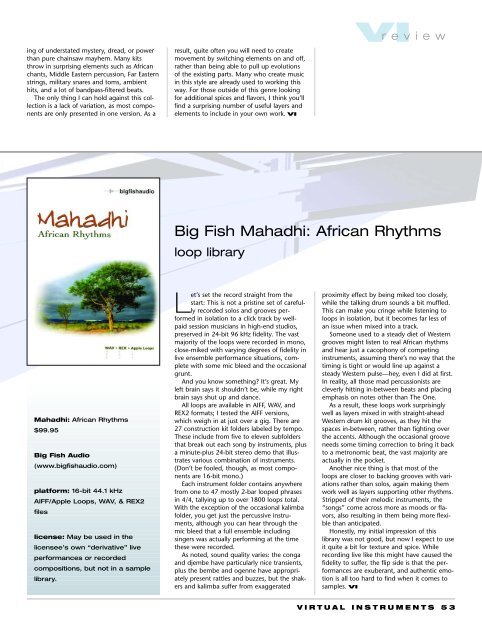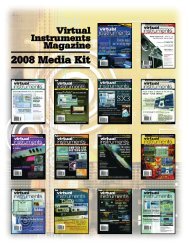Akai EWI 4000m Electric Wind Instrument Akai EWI 4000m Electric ...
Akai EWI 4000m Electric Wind Instrument Akai EWI 4000m Electric ...
Akai EWI 4000m Electric Wind Instrument Akai EWI 4000m Electric ...
You also want an ePaper? Increase the reach of your titles
YUMPU automatically turns print PDFs into web optimized ePapers that Google loves.
ing of understated mystery, dread, or power<br />
than pure chainsaw mayhem. Many kits<br />
throw in surprising elements such as African<br />
chants, Middle Eastern percussion, Far Eastern<br />
strings, military snares and toms, ambient<br />
hits, and a lot of bandpass-filtered beats.<br />
The only thing I can hold against this collection<br />
is a lack of variation, as most components<br />
are only presented in one version. As a<br />
Mahadhi: African Rhythms<br />
$99.95<br />
Big Fish Audio<br />
(www.bigfishaudio.com)<br />
platform: 16-bit 44.1 kHz<br />
AIFF/Apple Loops, WAV, & REX2<br />
files<br />
license: May be used in the<br />
licensee’s own “derivative” live<br />
performances or recorded<br />
compositions, but not in a sample<br />
library.<br />
result, quite often you will need to create<br />
movement by switching elements on and off,<br />
rather than being able to pull up evolutions<br />
of the existing parts. Many who create music<br />
in this style are already used to working this<br />
way. For those outside of this genre looking<br />
for additional spices and flavors, I think you’ll<br />
find a surprising number of useful layers and<br />
elements to include in your own work. VI<br />
Let’s set the record straight from the<br />
start: This is not a pristine set of carefully<br />
recorded solos and grooves performed<br />
in isolation to a click track by wellpaid<br />
session musicians in high-end studios,<br />
preserved in 24-bit 96 kHz fidelity. The vast<br />
majority of the loops were recorded in mono,<br />
close-miked with varying degrees of fidelity in<br />
live ensemble performance situations, complete<br />
with some mic bleed and the occasional<br />
grunt.<br />
And you know something? It’s great. My<br />
left brain says it shouldn’t be, while my right<br />
brain says shut up and dance.<br />
All loops are available in AIFF, WAV, and<br />
REX2 formats; I tested the AIFF versions,<br />
which weigh in at just over a gig. There are<br />
27 construction kit folders labeled by tempo.<br />
These include from five to eleven subfolders<br />
that break out each song by instruments, plus<br />
a minute-plus 24-bit stereo demo that illustrates<br />
various combination of instruments.<br />
(Don’t be fooled, though, as most components<br />
are 16-bit mono.)<br />
Each instrument folder contains anywhere<br />
from one to 47 mostly 2-bar looped phrases<br />
in 4/4, tallying up to over 1800 loops total.<br />
With the exception of the occasional kalimba<br />
folder, you get just the percussive instruments,<br />
although you can hear through the<br />
mic bleed that a full ensemble including<br />
singers was actually performing at the time<br />
these were recorded.<br />
As noted, sound quality varies: the conga<br />
and djembe have particularly nice transients,<br />
plus the bembe and ogenne have appropriately<br />
present rattles and buzzes, but the shakers<br />
and kalimba suffer from exaggerated<br />
VI review<br />
Big Fish Mahadhi: African Rhythms<br />
loop library<br />
proximity effect by being miked too closely,<br />
while the talking drum sounds a bit muffled.<br />
This can make you cringe while listening to<br />
loops in isolation, but it becomes far less of<br />
an issue when mixed into a track.<br />
Someone used to a steady diet of Western<br />
grooves might listen to real African rhythms<br />
and hear just a cacophony of competing<br />
instruments, assuming there’s no way that the<br />
timing is tight or would line up against a<br />
steady Western pulse—hey, even I did at first.<br />
In reality, all those mad percussionists are<br />
cleverly hitting in-between beats and placing<br />
emphasis on notes other than The One.<br />
As a result, these loops work surprisingly<br />
well as layers mixed in with straight-ahead<br />
Western drum kit grooves, as they hit the<br />
spaces in-between, rather than fighting over<br />
the accents. Although the occasional groove<br />
needs some timing correction to bring it back<br />
to a metronomic beat, the vast majority are<br />
actually in the pocket.<br />
Another nice thing is that most of the<br />
loops are closer to backing grooves with variations<br />
rather than solos, again making them<br />
work well as layers supporting other rhythms.<br />
Stripped of their melodic instruments, the<br />
“songs” come across more as moods or flavors,<br />
also resulting in them being more flexible<br />
than anticipated.<br />
Honestly, my initial impression of this<br />
library was not good, but now I expect to use<br />
it quite a bit for texture and spice. While<br />
recording live like this might have caused the<br />
fidelity to suffer, the flip side is that the performances<br />
are exuberant, and authentic emotion<br />
is all too hard to find when it comes to<br />
samples. VI<br />
VIRTUAL INSTRUMENTS 53



